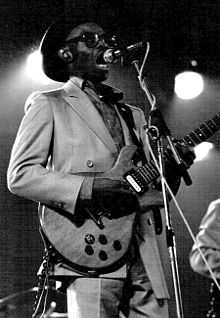J. B. Hutto
| J. B. Hutto | |
|---|---|
 J.B. Hutto in France in December 1982 | |
| Background information | |
| Birth name | Joseph Benjamin Hutto |
| Born |
April 26, 1926 Blackville, South Carolina, United States |
| Died |
June 12, 1983 (aged 57) Harvey, Illinois, United States |
| Genres | Blues |
| Occupation(s) | Musician |
| Instruments | Vocals, guitar, slide guitar |
| Years active | 1954–1983 |
J. B. Hutto (April 26, 1926 – June 12, 1983)[1] was an American blues musician. Hutto was influenced by Elmore James, and became known for his slide guitar work and declamatory style of singing. He was inducted into the Blues Hall of Fame two years after his death.
Life and career
Joseph Benjamin Hutto was born in Blackville, South Carolina, the fifth of seven children. His family moved to Augusta, Georgia when Hutto was three years old. His father, Calvin, was a preacher and Hutto, along with his three brothers and three sisters, formed a gospel group called The Golden Crowns, singing in local churches. Hutto's father died in 1949, and the family relocated to Chicago.[2] Hutto served as a draftee in the Korean War in the early 1950s, driving trucks in combat zones.[3]
In Chicago, Hutto took up the drums and played with Johnny Ferguson and his Twisters. He also tried the piano before settling on the guitar and playing on the streets with the percussionist Eddie 'Porkchop' Hines. After adding Joe Custom on second guitar, they started playing club gigs, and harmonica player George Mayweather joined after sitting in with the band. Hutto named his band The Hawks, after the wind that blows in Chicago.[4] A recording session in 1954 resulted in the release of two singles on the Chance label and a second session later the same year, with the band supplemented by pianist Johnny Jones, produced a third.[5]
Later in the 1950s Hutto became disenchanted with music, and gave it up after a woman broke his guitar over her husband's head one night in a club where he was performing; during the next eleven years Hutto worked as a janitor in a funeral home to supplement his income.[6] He returned to the music industry in the mid-1960s, with a new version of the Hawks featuring Herman Hassell on bass and Frank Kirkland on drums.[7] His recording career resumed with, first, a session for Vanguard Records released on the compilation album Chicago/the Blues/Today! Vol. 1, and then albums for Testament and Delmark.[8] The 1968 Delmark album, Hawk Squat!, which featured Sunnyland Slim on organ and piano, and Maurice McIntyre on tenor saxophone, is regarded as his best work on album up to this point.[9]
After Hound Dog Taylor died in 1975, Hutto took over his band the Houserockers for a time, and in the late 1970s he moved to Boston and recruited a new band which he called the New Hawks, with whom he recorded further studio albums for the Varrick label.[7] His 1983 Varrick album Slippin' & Slidin', the last of his career and later reissued on CD as Rock With Me Tonight, has been described as "near-perfect".[9]
Death and legacy
In the early 1980s Hutto returned to Illinois, where he was diagnosed with cancer. He died in 1983, at the age of 57, in Harvey. He was interred at Restvale Cemetery, Alsip, Illinois.[10]
In 1985, the Blues Foundation inducted Hutto into its Hall of Fame.[11] His nephew, Lil' Ed Williams (of Lil' Ed and the Blues Imperials) has carried on his legacy, playing and singing in a style close to his uncle's.[12]
A "J.B. Hutto" model guitar is often used to refer to a mid-1960s, red, Montgomery Ward Res-O-Glas Airline guitar. Although he was not a paid endorser, Hutto made the guitar famous by appearing with it on the cover of his Slidewinder album.
Discography
Singles
- 1954 – J. B. and His Hawks – "Combination Boogie" / "Now She’s Gone" (Chance Records; CH-1155).
- 1954 – J. B. and His Hawks – "Lovin' You" / "Pet Cream Man" (Chance Records; CH-1160).
- 1954 – J. B. Hutto and His Hawks – "Dim Lights" / "Things Are So Slow" (Chance Records; CH-1165).
See also
References
- ↑ Allmusic biography -accessed January 2008
- ↑ Rowe 1981, p. 114
- ↑ van Rijn 2004, p. 97
- ↑ Rowe 1981, p. 114-5
- ↑ Ledbitter and Slaven 1987, p. 650
- ↑ "J.B. Hutto". Cascadeblues.org. 1926-04-26. Retrieved 2011-12-30.
- ↑ 7.0 7.1 Cascadeblues.org biography – accessed May 2008
- ↑ Ledbitter and Slaven 1987, p. 650-651
- ↑ 9.0 9.1 Russell, T. and Smith, S. (2006): The Penguin Guide To Blues Recordings. London: Penguin Books, p. 299, ISBN 978-0-14-051384-4
- ↑ Find A Grave website – accessed May 2008
- ↑ Blues Foundation: 1985 Hall of Fame Inductees – accessed May 2008
- ↑ Russell, Tony (1997). The Blues – From Robert Johnson to Robert Cray. Dubai: Carlton Books Limited. p. 121. ISBN 1-85868-255-X.
Bibliography
- Leadbitter, M. and Slaven, N. (1987), Blues Records 1943 to 1970 Vol. 1, 2nd Ed., London: Record Information services
- Rowe, M. (1981): Chicago Blues: the City and the Music, Da Capo Press
- van Rijn, G. (2004): The Truman and Eisenhower Blues, Continuum
External links
|